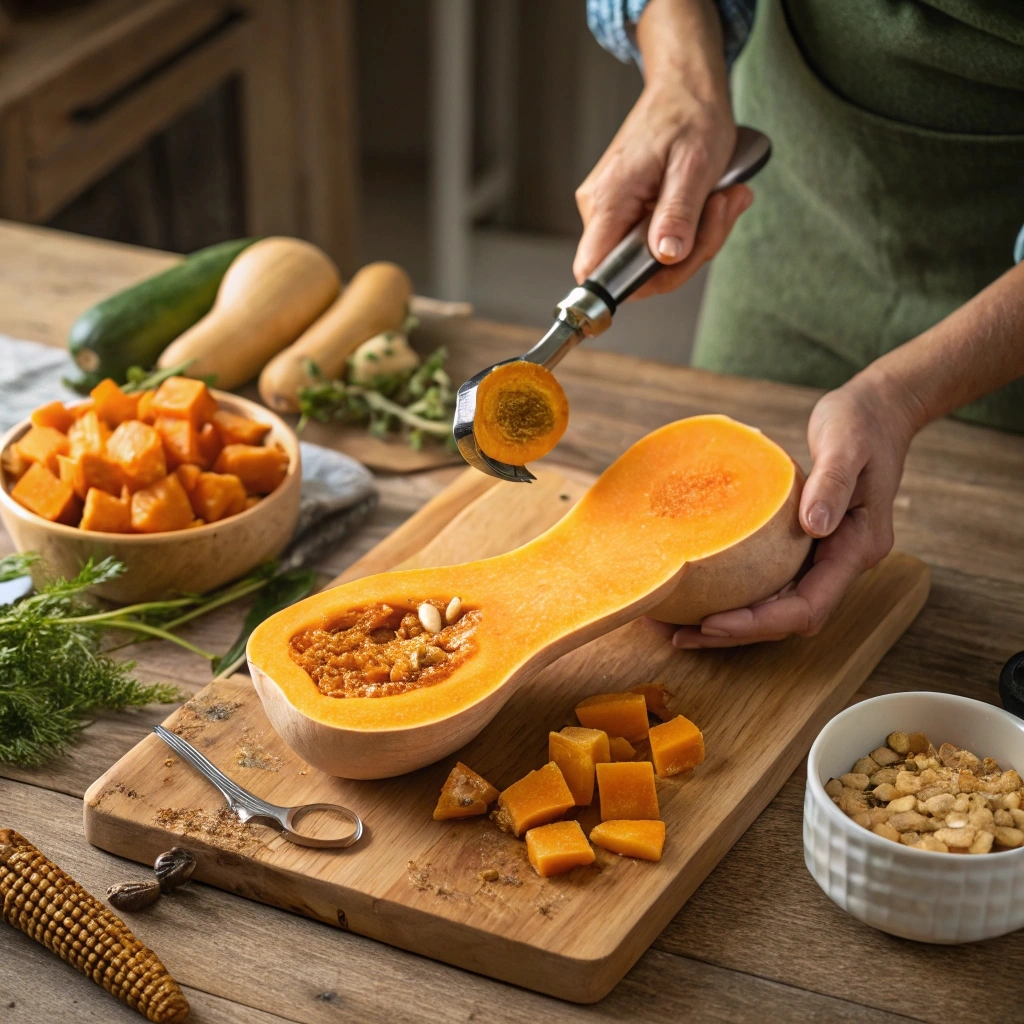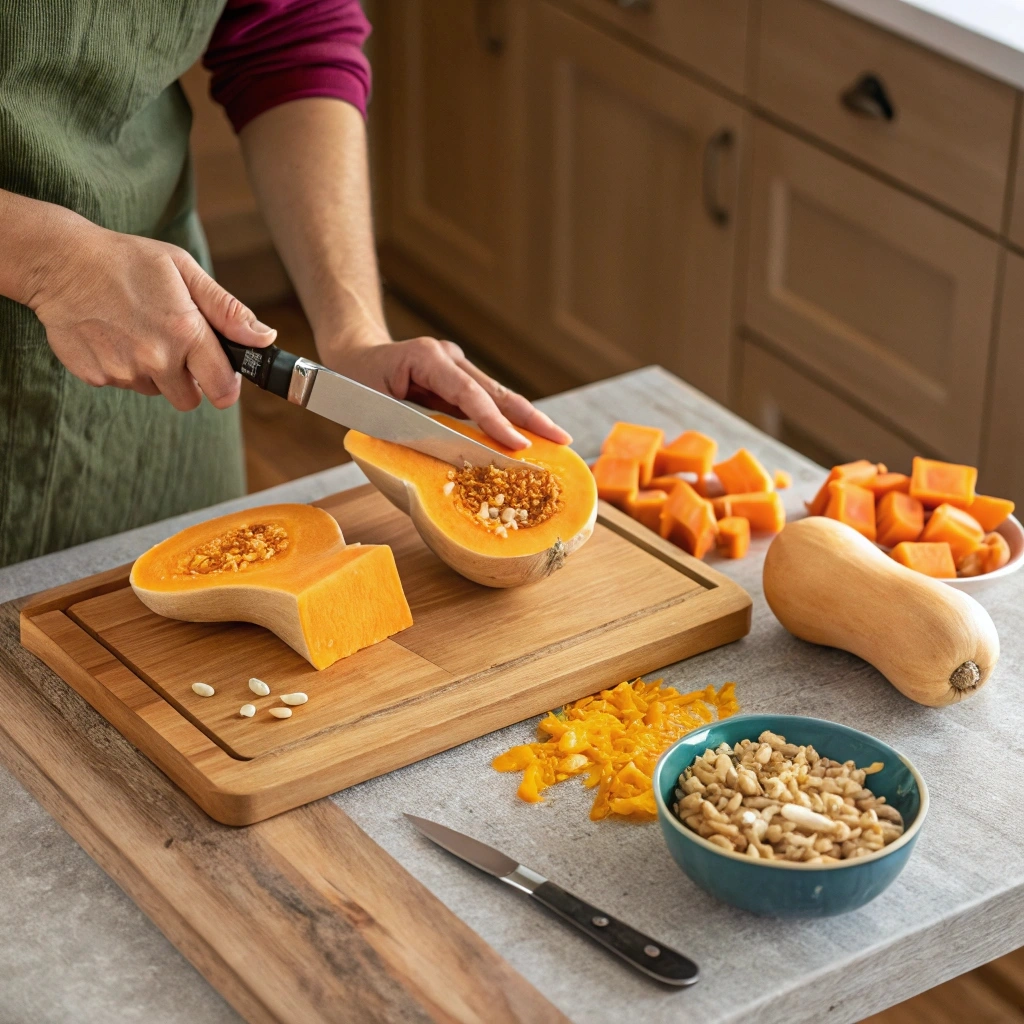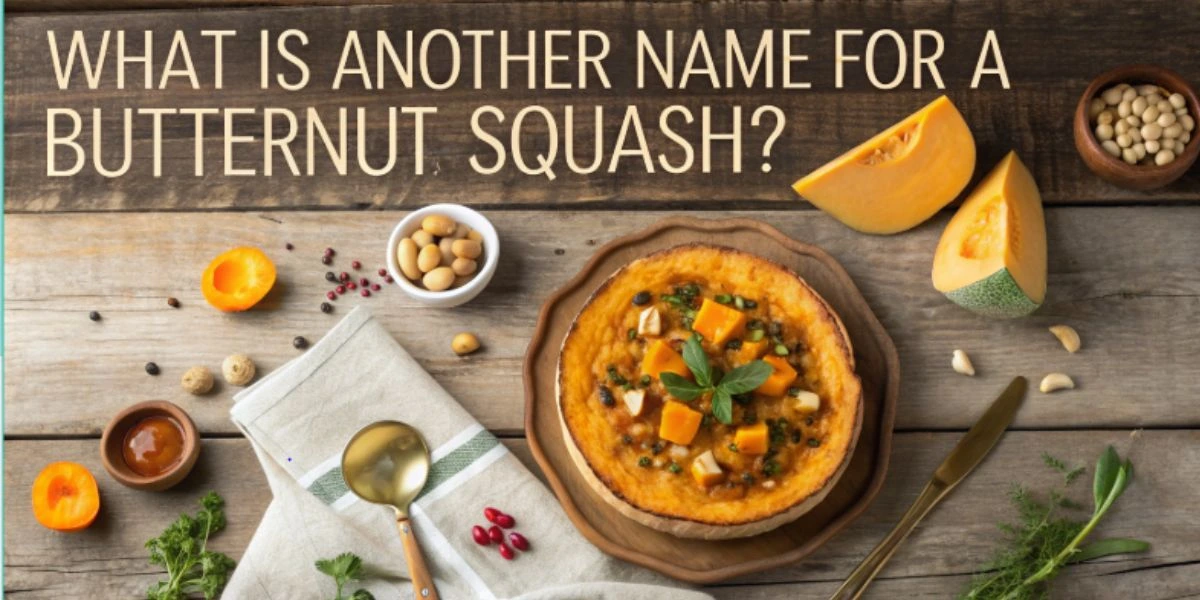Butternut squash, with its smooth texture and naturally sweet, nutty flavor, remains a favorite in kitchens across the globe. Its ability to shine in both savory dishes, such as soups and casseroles, and sweet creations, like pies and desserts, showcases its versatility. As a result, it has earned a permanent spot in many households, especially during fall and winter. Its versatility makes it an excellent match for various ingredients, from aromatic spices to fresh herbs.
Butternut squash is often called winter squash.
Many people, however, wonder, “What is another name for a butternut squash?” This question comes up because the vegetable is called by various names depending on the region and culture. For example, in Australia and New Zealand, it is often referred to as “butternut pumpkin,” while in the United Kingdom and South Africa, it’s commonly called simply “butternut.” These variations highlight how the squash has integrated itself into diverse cuisines, adapting to local culinary traditions.
In addition to exploring its alternative names, this article will dive into the origins of butternut squash, its cultural importance, and its role in global cuisines. Furthermore, we will discuss its impressive nutritional profile and provide step-by-step tips for preparing it at home. By the end, you’ll gain a deeper understanding of why butternut squash is not just a vegetable but a culinary cornerstone cherished worldwide.
For more ideas, explore our collection of quick and easy Dinner recipes
What Is Another Name for a Butternut Squash?
Butternut squash is often called winter squash. depends on where you are. While “butternut squash” is the most commonly used term in the United States, other names have emerged globally:
Regional Names for Butternut Squash
- Australia and New Zealand: Often called butternut pumpkin due to its resemblance to other pumpkin varieties.
- United Kingdom and South Africa: Commonly referred to as simply butternut.
- United States and Canada: Known universally as butternut squash.
The History of Butternut Squash
How the Name Reflects Its Qualities
The name butternut aptly captures the squash’s distinctive qualities. For instance, its buttery texture and mild, nut-like flavor inspired farmers to give it a name that highlights these appealing traits. This practical naming choice not only reflects its culinary attributes but also made it easier to market to a wider audience, ensuring its place as a household favorite.
Cultural and Historical Significance
Native American Use
Squash was an essential part of the diets of Indigenous peoples, valued for its versatility and nutrition. They frequently combined it with beans and corn—forming the “Three Sisters” agricultural system—to create stews and porridges that provided balanced nutrition.
Colonial Adoption
As European settlers arrived, they quickly integrated squash into their diets. Over time, it became a foundation for classic dishes like creamy squash soup, which remains popular in American cuisine today.
Modern Popularity
In modern times, butternut squash has evolved into a key ingredient in both traditional and innovative recipes. For example, it is widely used in roasted vegetable medleys, hearty vegan casseroles, and even sweet desserts like squash-based pies. Its versatility and nutritional value continue to drive its popularity, making it a staple in kitchens across the globe.
Nutritional Benefits of Butternut Squash
Butternut squash is not just flavorful; it’s also packed with nutrients that support overall health.
Key Nutrients
Vitamin A: Supports good eyesight and enhances immune system function. - Vitamin C: Enhances immune function and contributes to healthy sk
- Potassium: Assists in controlling blood pressure and maintaining healthy muscle activity.
- Fiber: Improves digestion and aids in weight management.
Health Benefits
- Enhances Eye Health: Its Vitamin A content helps protect against vision-related issues.
- Strengthens Immunity: The high levels of Vitamin C help the body fight off illnesses.
- Supports Heart Health: Potassium lowers blood pressure, reducing the risk of cardiovascular problems.
- Promotes Digestive Health: The fiber content aids in maintaining a healthy gut.
| Nutrient | Amount | Health Benefits |
|---|---|---|
| Calories | 45 kcal | Provides energy while being low in calories, supporting weight management. |
| Carbohydrates | 11.7 g | Acts as a primary energy source for daily activities. |
| Dietary Fiber | 2 g | Promotes healthy digestion and helps prevent constipation. |
| Vitamin A | 10630 IU | Supports eye health, boosts immunity, and enhances skin health. |
| Vitamin C | 21 mg | Strengthens the immune system and supports collagen production for healthy skin. |
| Potassium | 284 mg | Helps regulate blood pressure and supports cardiovascular health. |
| Magnesium | 17 mg | Plays a role in muscle function, bone health, and energy production. |
| Calcium | 48 mg | Contributes to strong bones and teeth. |
| Protein | 1 g | Aids in muscle repair and maintenance. |
| Fat | 0.1 g | Extremely low in fat, making it a heart-healthy choice. |
This table highlights the nutritional value of butternut squash, demonstrating its versatility as a healthy ingredient in a balanced diet.
For more information on the nutritional value of squash, visit Healthline.
How to Prepare Butternut Squash
Preparing butternut squash is simple and rewarding. Its natural sweetness and smooth texture make it ideal for a variety of recipes.
Steps to Prepare Butternut Squash
- Wash: Thoroughly rinse the squash to ensure it is clean and free of dirt.
- Cut in Half: Remove the tough outer skin using a vegetable peeler.
- Cut in Half: Carefully slice the squash lengthwise and remove the seeds.
- Dice or Slice: Depending on your recipe, cut the squash into cubes or slices.
Popular Cooking Methods
- Roasting:
- Preheat your oven to 400°F (200°C).
- Coat squash cubes with olive oil and season with salt and pepper.
- Roast: Cook in the oven for 30–40 minutes, stirring halfway to ensure even cooking.
- Steaming:
- Steam squash by placing the pieces in a basket positioned above boiling water.
- Cover and steam the squash for 15–20 minutes until tender.
- Pureeing:
- Blend roasted or steamed squash into a smooth puree.
- Use in soups, sauces, or desserts for a creamy texture.


How Butternut Squash Is Used in Global Cuisines
Butternut squash, known by different names across the globe, is a versatile ingredient that enhances a wide variety of dishes. Its adaptability allows it to fit seamlessly into diverse culinary traditions, making it a favorite ingredient worldwide.
In the United States
the United States, butternut squash is a quintessential ingredient during the fall and winter months.
- Soups: For example, creamy butternut squash soup is a classic, offering a warm and comforting dish for colder seasons.
- Casseroles: This squash adds a rich and creamy texture to baked casseroles, making them more flavorful and satisfying.
- Roasted Side Dishes: It is often roasted alongside root vegetables, creating a hearty and nutritious side dish.
In Europe
European cuisines have embraced butternut squash in unique ways, reflecting their distinct culinary styles.
- Italy: In Italian cooking, butternut squash is featured in risottos and used as a filling for ravioli, paired with sage butter for a classic combination.
- France: French chefs frequently incorporate it into pureed soups or use it in savory tarts, highlighting its creamy texture.
- United Kingdom: In the UK, butternut squash is commonly roasted as a side dish or blended into soups, offering a versatile addition to seasonal meals.
In Asia
Asian cuisines utilize butternut squash for its ability to absorb bold flavors and enhance traditional dishes.
- India: In Indian cooking, butternut squash is added to curries and spiced stews, complementing the robust spices used in these dishes.
- Thailand: Thai cuisine often incorporates butternut squash in soups and stir-fries, especially those made with coconut milk, to balance savory and sweet flavors.
In South America
In South American kitchens, butternut squash is a beloved ingredient for its natural sweetness and smooth consistency.
- Argentina: In Argentina, it is commonly included in hearty stews, where it adds both sweetness and a creamy texture.
- Brazil: Brazilian recipes often use butternut squash blended into soups or pureed for desserts, showcasing its versatility in both savory and sweet applications.
Through its ability to adapt to various flavor profiles and cooking methods, butternut squash has secured a place in global cuisines, delighting palates with its rich taste and nutritional benefits.
Sustainability and Zero-Waste Cooking with Butternut Squash
Butternut squash is a sustainable vegetable that aligns with eco-friendly cooking practices.
Why It’s a Sustainable Choice
- Long Shelf Life: Reduces food waste by staying fresh for months.
- Zero-Waste Potential: Seeds can be roasted, and peels can be composted.
- Low Resource Requirements: Requires minimal water and fertilizer to grow.
FAQs about “What Is Another Name for a Butternut Squash?”
What is another name for a butternut squash?
In some parts of the world, people refer to butternut squash as “butternut pumpkin,” especially in countries like Australia and New Zealand. Similarly, in the United Kingdom and South Africa, it’s often simply called “butternut.” These regional differences reflect how the vegetable has adapted to local naming conventions, often influenced by its resemblance to other squash or pumpkin varieties.
Why is it called butternut squash?
The name butternut squash describes the vegetable’s signature qualities, including its creamy, buttery texture and mildly nutty flavor. These characteristics make it unique among winter squashes and provide a fitting name that appeals to its culinary uses. In addition, the term helps distinguish it from other squash types with firmer textures or less sweet profiles.
How do you prepare butternut squash?
Preparing butternut squash involves simple yet essential steps to ensure the best results.Start by washing the squash thoroughly under running water to eliminate any dirt. Next, peel the tough outer skin with a vegetable peeler. Next, slice the squash lengthwise and use a spoon to scoop out the seeds. You can then dice it into cubes or slice it into desired shapes, depending on your recipe. For example, cubed squash works well in roasted dishes, while thin slices are ideal for layering in casseroles.
Can you substitute butternut squash?
Yes, you can substitute butternut squash with other vegetables that offer similar flavors and textures. Great alternatives include:
- Acorn squash: Provides a slightly nuttier taste with a similar texture.
- Spaghetti squash: Works well for lighter dishes with a stringy, pasta-like consistency.
- Sweet potatoes: Offer a comparable sweetness and soft texture in recipes like soups or casseroles.
When substituting, consider adjusting cooking times or seasoning to match the flavors of the replacement ingredient.
What makes butternut squash a sustainable choice?
Butternut squash stands out as an eco-friendly option for several reasons. Its long shelf life reduces the need for frequent grocery trips and minimizes food waste. Additionally, the seeds can be roasted for a healthy snack, and the peels can be composted, promoting zero-waste cooking practices. Furthermore, this vegetable grows in various climates with minimal resource requirements, making it an excellent choice for sustainable farming. As a result, butternut squash contributes to a more environmentally friendly approach to eating and cooking.
Conclusion about What is another name for a butternut squash?
Butternut squash, often referred to as butternut pumpkin or simply butternut, is widely recognized for its versatility and exceptional nutritional value. This vegetable consistently stands out due to its naturally sweet flavor, creamy texture, and ability to elevate a variety of recipes. For instance, it fits seamlessly into hearty soups, comforting casseroles, and even indulgent desserts, proving itself as a true kitchen essential.
Moreover, butternut squash offers numerous health benefits, making it a smart choice for any diet. Packed with vital nutrients like Vitamin A, Vitamin C, potassium, and fiber, it supports immune function, promotes healthy digestion, and strengthens bones. In addition, its low calorie and fat content make it ideal for those seeking a balance between nutritious and flavorful meals.
Furthermore, its adaptability in the kitchen is unparalleled. For example, roasting butternut squash enhances its natural caramelized sweetness, while pureeing it creates a smooth, creamy base for soups or sauces. Additionally, it works wonderfully in baked dishes like savory pies, adding depth and richness.
Beyond its culinary appeal, butternut squash also contributes to sustainable cooking. Its long shelf life reduces food waste, and it requires minimal resources to grow, making it an eco-friendly option. As a result, it is a great choice for those looking to incorporate sustainable practices into their cooking habits.
When planning your next meal, consider adding butternut squash to your menu. Its ability to combine flavor and nutrition, along with its global culinary appeal, ensures that this vegetable will remain a cherished ingredient for years to come.

